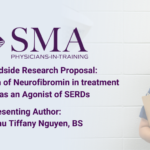Abstract | May 4, 2021
Bench to Bedside Research Proposal: Novel Application of Neurofibromin in treatment of Breast as an Agonist of SERDs
Learning Objectives
- One of the most recent therapeutic research in breast cancer pathophysiology;
- New adjunct therapy to the standard of care for ER+ breast cancer;
- Propose bench to bedside translation of this particular potential therapeutic agent.
Research shows that neurofibromin has protective mechanisms to decrease ER hypersensitivity and aid in SERD therapy as an agonist. A decrease in neurofibromin in patients with ER+ breast cancer will initially respond well to selective ER degraders (SERDs). Subsequently, an acquired resistance to SERD therapy may occur in patients that are neurofibromin depleted. Having discovered the role that neurofibromin plays on a molecular level in mouse models, we propose steps toward clinical trials. The first step would be to explore the relevance of this finding in clinical settings. To do that, we will do a literature review to gather data from other studies on related research with findings that support our conclusion. We will also explore possible collaborations with pharmaceutical companies and Breast Cancer centers on a national and international level. With the collaborations, we will have better estimates about the cost of this study and hence, will write grant NIH proposal for funding. The final step is to carry out the clinical trials in all the centers in four phases. We will begin in phase 1 with a small sample size of healthy adult volunteers for safety purposes. Phase 2 will have an increased number of volunteers or patients to assess for efficacy and adverse effects. Phase 3 will have a larger number of patients that are randomly assigned for treatment or a placebo to compare the new treatment to the current standard of care.
The final phase will be to observe the patients after the treatment has been approved to monitor adverse effects that may result long-term. We hope to have this novel therapeutic approved by the FDA in order to help the ER+ breast cancer patient population in the near future.

